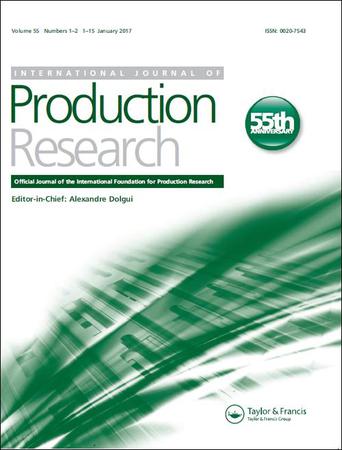能源-水-碳足迹协同管理:空间网络特征分析
IF 7
2区 工程技术
Q1 ENGINEERING, INDUSTRIAL
International Journal of Production Research
Pub Date : 2023-09-21
DOI:10.1080/00207543.2023.2258225
引用次数: 0
摘要
摘要人类活动造成的水、能源消耗和碳排放对自然环境有着重要的影响。由于全球环境污染问题严重,了解这些因素之间的关系正成为实现可持续发展的重要途径。然而,随着区域间贸易联系的加强,很难管理和评价它们之间的关系。为此,本研究从区域和产业的角度出发,运用多区域投入产出(MRIO)模型和社会网络分析(SNA),探索了一种创新的评价能源-水-碳空间网络特征的分析方法,并提出了改进方案。结果表明,水资源短缺和能源富集的特征导致了水足迹的净流入和能源足迹和碳足迹的净流出。此外,传统的高能耗工业部门对能源和碳足迹的贡献很大。资源型地区能源-水-碳空间网络相关性低且不稳定,缺乏理性化和平衡性。基于网络的能源-水-碳研究为理解工业供应链的碳减排责任提供了更多的见解。研究结果可为中国减少能源-水-碳足迹,实现碳减排目标提供参考。关键词:协同管理能源-水-碳足迹多区域投入产出分析社会网络分析空间网络致谢我们也感谢匿名评论者和编辑提出的有益建议。披露声明作者未报告潜在的利益冲突。数据可用性声明作者确认在文章中可以获得支持本研究结果的数据。本研究得到国家自然科学基金项目(批准号:42001257和71874119)、山西省高校哲学社会科学研究项目(批准号:20210115)和山西省2022年重大决策咨询项目(批准号:2005)的资助。作者简介刘秀丽,山西财经大学(太原)资源经济研究所教授。2013年6月毕业于西北师范大学自然地理专业,获博士学位。主要研究方向为区域经济管理、能源生态、资源型经济转型。在本文中,她主要负责构思、审稿和编辑工作。熊锐,山西财经大学(太原)资源经济研究所研究生。主要研究方向为资源环境与区域可持续发展、能源生态、资源型经济转型。在本文中,她主要负责文章的审稿和编辑工作。Sandun C. Perera,他是内华达大学里诺分校商学院商业分析和运营副教授。他的研究重点是运营管理、供应链管理、医疗保健运营管理中的颠覆性技术,以及运营与业务中其他功能领域之间的接口。在这篇论文中,他主要负责监督、撰稿和编辑。郭丕斌,山西经济管理学院教授。主要从事科技创新、区域发展、能源技术创新研究。中国山西省名师,山西省学术技术带头人。在本文中,他的贡献是提出方法。本文章由计算机程序翻译,如有差异,请以英文原文为准。
Collaborative management of the energy-water-carbon footprint: analysing the spatial network characteristics
AbstractWater and energy consumption and carbon emissions caused by humans have vital impacts on the natural environment. Due to the dramatic global environmental pollution problem, understanding the relationship between these factors is emerging as an important approach to realising sustainable development. However, with the strengthening of interregional trade links, it is difficult to manage and evaluate their relationship. Therefore, from the perspective of regional and industrial sectors, using the multiregional input-output (MRIO) model and social network analysis (SNA), our research explores an innovative analytical methodology to evaluate the characteristics of the energy-water-carbon spatial network, and a scheme is proposed to improve it. The results demonstrate that the characteristics of water scarcity and energy enrichment could lead to a net inflow of the water footprint and a net outflow of the energy and carbon footprints. Moreover, traditional high-energy-consumption industrial sectors contribute significantly to the energy and carbon footprints. The energy-water-carbon spatial network correlation is low and unstable, and it lacks rationalisation and balance in resource-based areas. Network-based energy-water-carbon research provides more insights toward understanding the carbon emission reduction responsibilities of industrial supply chains. Our findings provide a reference for reducing the energy-water-carbon footprint and achieving the carbon reduction goal of China.KEYWORDS: Collaborative managementenergy-water-carbon footprintmultiregional input–output analysissocial network analysisspatial network AcknowledgmentsWe also thank anonymous commentators and editors for their helpful suggestions.Disclosure statementNo potential conflict of interest was reported by the author(s).Data availability statementThe authors confirm that the data supporting the findings of this study are available within the article.Additional informationFundingThis research was supported by the National Natural Science Foundation of China (Grant No. 42001257 and 71874119), the Research on Philosophy and Social Sciences in Shanxi Province's Colleges and Universities (Grant No. 20210115), and the Major decision-making consulting projects in Shanxi Province in 2022 (Grant No. 2005).Notes on contributorsXiuli LiuXiuli Liu is a Professor in the Research Institute of Resource-based Economics at Shanxi University of Finance and Economics (Taiyuan, China). She received her Ph.D. in Natural Geography from Northwest Normal University (Gansu, China) in June 2013. Her research interests include regional economic management, energy ecology, and resource-based economic transformation. In this paper, she is mainly responsible for conceptualization, writing – review, and editing.Rui XiongRui Xiong is a graduate student in the Research Institute of Resource-based Economics at Shanxi University of Finance and Economics (Taiyuan, China). Her research interests include resource environment and regional sustainable development, energy ecology, and resource-based economic transformation. In this paper, she is mainly responsible for writing – reviewing, and editing.Sandun C. PereraSandun C. Perera is an Associate Professor of Business Analytics and Operations at the College of Business, University of Nevada, Reno. His research focuses on Disruptive Technologies in Operations Management, Supply Chain Management, Healthcare Operations Management, and interfaces between Operations and other functional areas in business. In this paper, he is mainly responsible for supervision, writing – review, and editing.Pibin GuoPibin Guo is a Professor at the Shanxi Institute of Economics Management. He is mainly committed to research on scientific and technological innovation, regional development, and energy technology innovation. He is a provincial famous teacher and a provincial academic and technical leader in Shanxi, China. In this paper, his contribution is to propose methods.
求助全文
通过发布文献求助,成功后即可免费获取论文全文。
去求助
来源期刊

International Journal of Production Research
管理科学-工程:工业
CiteScore
19.20
自引率
14.10%
发文量
318
审稿时长
6.3 months
期刊介绍:
The International Journal of Production Research (IJPR), published since 1961, is a well-established, highly successful and leading journal reporting manufacturing, production and operations management research.
IJPR is published 24 times a year and includes papers on innovation management, design of products, manufacturing processes, production and logistics systems. Production economics, the essential behaviour of production resources and systems as well as the complex decision problems that arise in design, management and control of production and logistics systems are considered.
IJPR is a journal for researchers and professors in mechanical engineering, industrial and systems engineering, operations research and management science, and business. It is also an informative reference for industrial managers looking to improve the efficiency and effectiveness of their production systems.
 求助内容:
求助内容: 应助结果提醒方式:
应助结果提醒方式:


